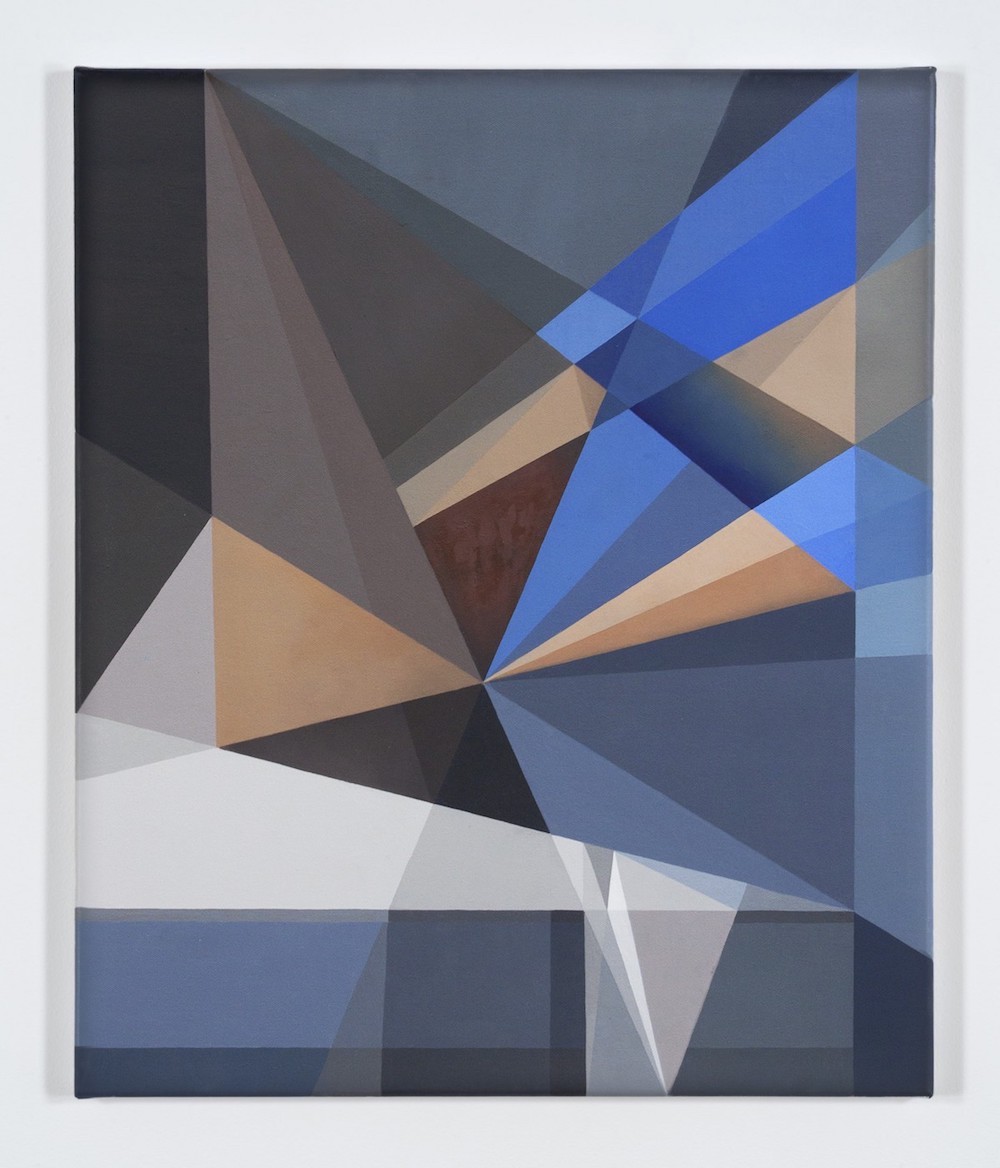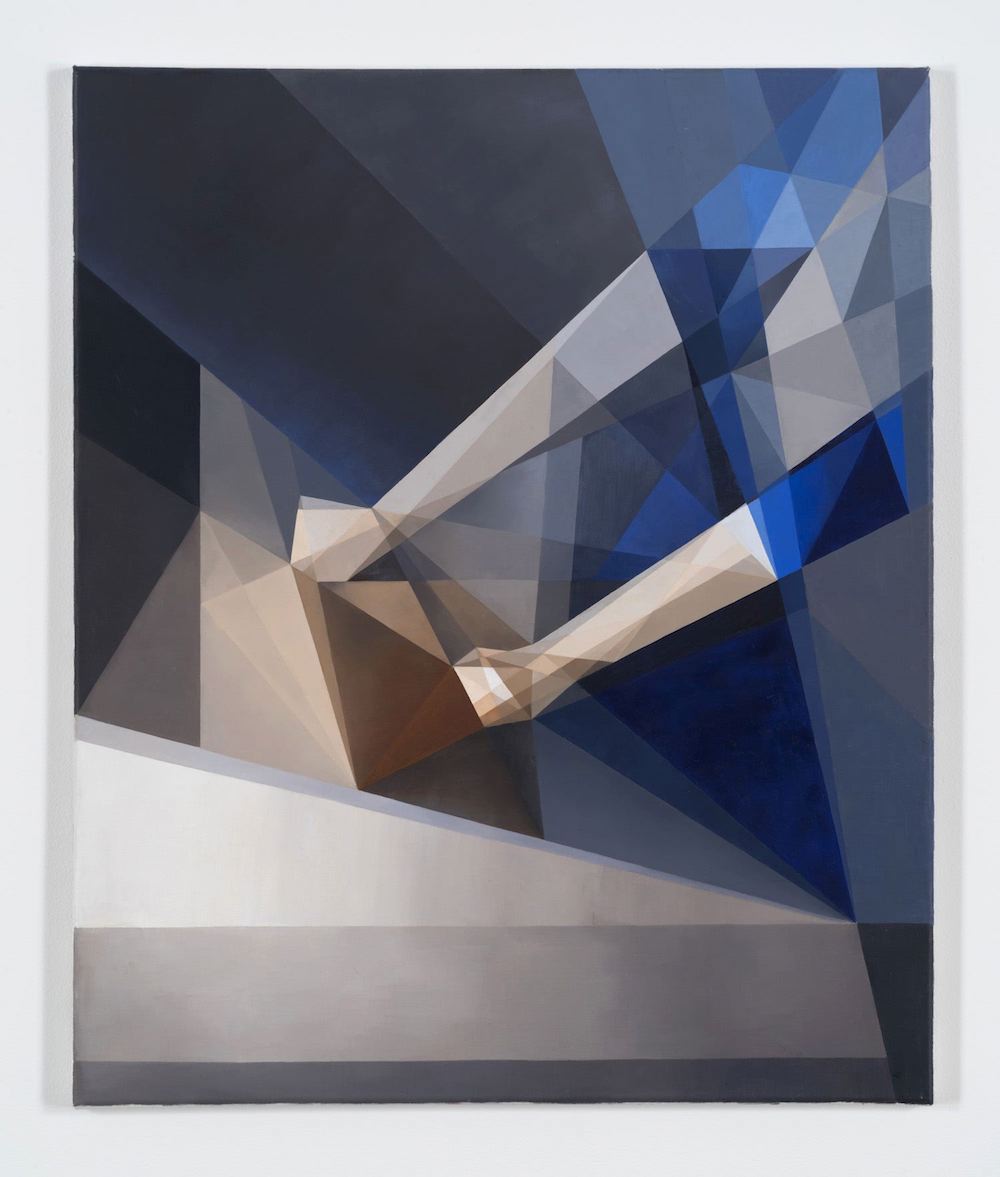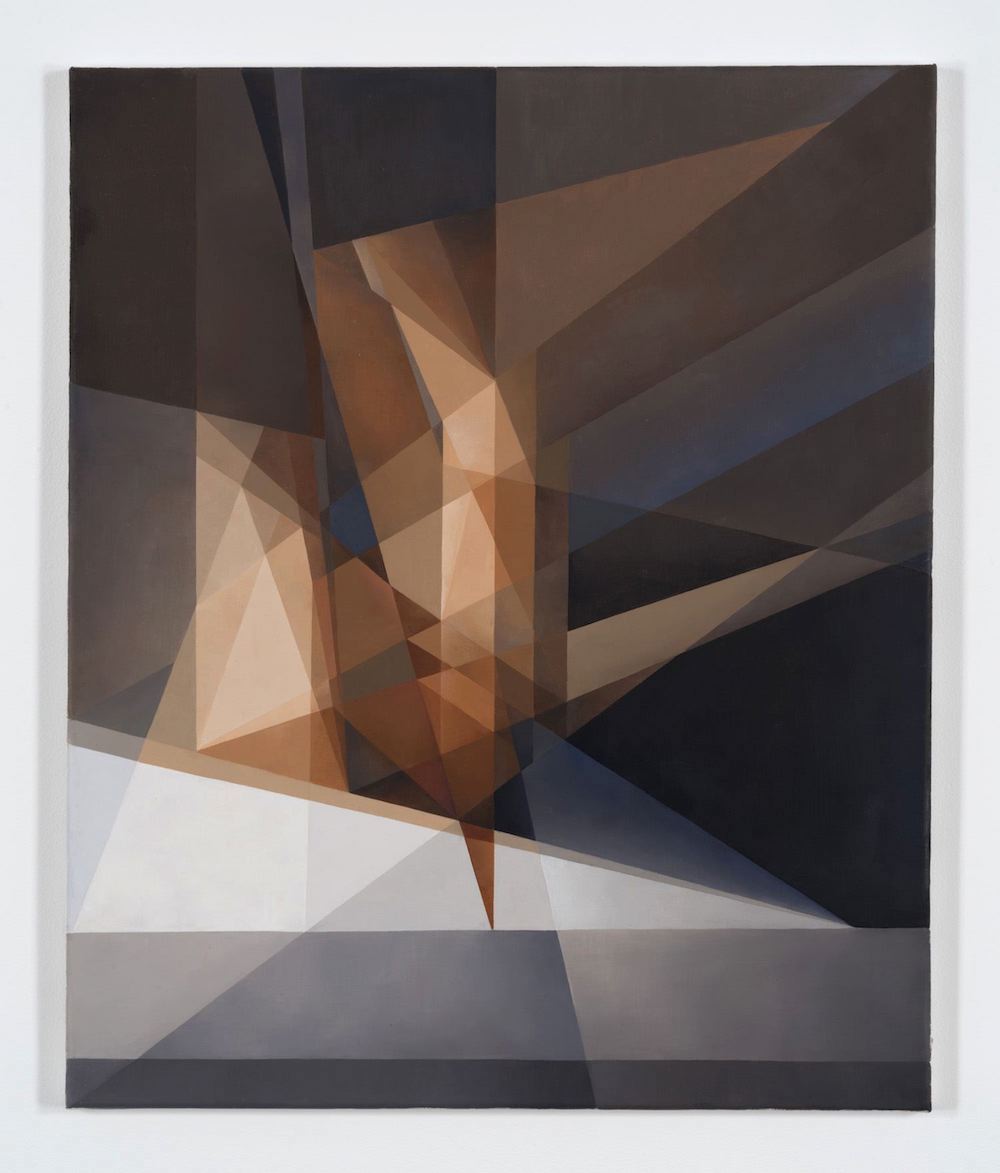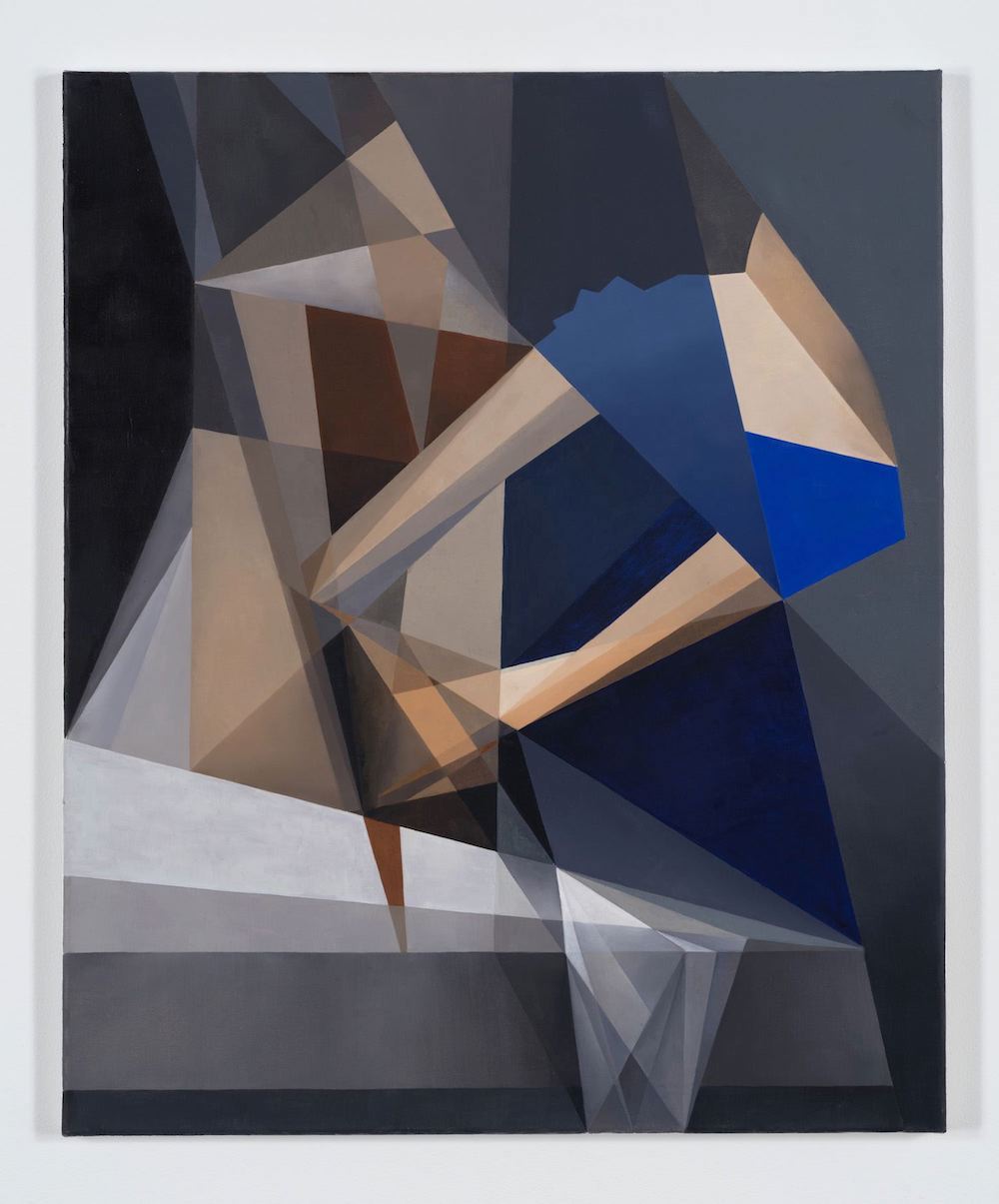In the winter of 2015, Ben Lerner wrote a short story, ‘The Polish Rider,’ incorporating fictionalized elements of the life and work of the artist, Anna Ostoya, who had recently lost two of her canvases in the back of an Uber. As the narrator of the story helps the artist search for the missing canvases, he fantasizes about “recuperating the lost paintings through prose,” about how the verbal might take the place of the visual. After the story was published in The New Yorker, Ostoya painted the painting Lerner had invented based on her earlier work, transforming the fiction without changing any of the words. Ostoya went on to produce a series of compositions that respond to the story she’d helped inspire. An excerpt is presented below.
That winter a small pneumonia bloomed in his left lung. He’d embarked on a second course of antibiotics, the first having proved insufficient. He was getting better, but was weak, and by about eight o’clock each night, profoundly so. Still, he wanted to see Anna and her opening in Chelsea. They made a plan to meet for an early drink downtown; they could catch up a little, then head to the opening together in a cab. He would look quickly around the gallery and rush back to bed in Brooklyn—another cab. (As long as he had an infection in his lung, it seemed, he could pay for private transportation without guilt. Taxis were on his mind; maybe he wouldn’t have otherwise written The Polish Rider). But he’d take the B train into Manhattan.
Stepping out of his apartment was like stepping out of a darkened theater; he had that feeling of super-sensitivity that attends a reemergence into public after a period of seclusion, streetlights startlingly bright, a nearby siren startlingly loud. Would he have written the story if he hadn’t met Anna in that condition? Over his soda water and her wine, he asked Anna how the installation of her show had gone, how she’d ultimately decided to hang the sequence of paintings she’d composed based on Artemisia Gentileschi’s monumental “Judith Slaying Holofernes.” He’d seen a few early versions of these paintings in her apartment (and studio) at 203 Rivington, on the Lower East Side. (The first few times he visited Anna’s place, he had a sense of déjà vu; finally he remembered that he and his wife had spent a couple of nights at 203 Rivington—in a friend of a friend’s apartment, whose layout was identical to Anna’s—some years before. If not for this coincidence, he might not have, etc.).
The Book of Judith—canonical for Catholics and Eastern Orthodox Christians, excluded by Protestants and Jews—tells the story of how Judith, a beautiful and courageous widow, ingratiates herself to Holofernes, an Assyrian general. One night when Holofernes is in a drunken stupor, Judith, accompanied by her maid, sneaks into his tent and cuts off his head, thus saving her town of Bethulia, which Holofernes planned to destroy. The scene was commonly painted, but he knew that Gentileschi’s version was famous both for the violence and power of the painting, and because it has long been read as “painted revenge” for Gentileschi’s rape by Agostino Tassi, a colleague of Gentileschi’s father, the painter Orazio. Tassi was a teacher of Gentileschi’s; many commentators see their features in the figures.
When he looked at reproductions of the Gentileschi “Judith” with Anna, he realized that, for him, that violence lay less in the spurting blood than in the furrowed brow of Judith, how it expresses, in addition to rage, the hard physical labor of cutting through bone and tissue; he compared it, as it is often compared, to Caravaggio’s version, where a delicate Judith could be cutting through butter. (Gentileschi’s painting was initially considered so violent it was confined to a “dark corner” of the Pitti Palace; now it’s in the Uffizi. Another version of Gentileschi’s “Judith” hangs in Naples, that doubling perhaps leading Anna to imagine using the image as a basis for a series in the first place.)
He spoke with Anna about Gentileschi’s tendency to depict women—strong women—in the majority of her canvases, the historical tendency of critics to undervalue her work, and the documentation of her rape (and the subsequent trial where the authenticity of her testimony was “confirmed” by torture)—some of the reasons why Gentileschi became an important figure for feminist artists and art historians. She also became a figure in popular culture: there is a feature film, multiple novels, plays about “Artemisia.” When he looked at Anna’s compositions, a whole complex of concerns was activated: the original painting(s), the biblical story, the historical rape, the history of the painting’s reception and that reception’s ongoing revision, both academic and popular, in which Gentileschi’s heroicization and victimization can be difficult to tease apart, and in which the boundaries between art and life are particularly vexed.
He also saw, how could he not see, the return of the beheading—and the spectacle of the beheading—as a contemporary form of violence. In the early 21st century, he felt, a beheading scene invariably evokes the so-called global war on terror and its repercussions, the confrontation between the respective fundamentalisms of the East and West, and the role of (new) media in the dissemination of terror, ideology. When he looked at Anna’s serial abstractions from—and variations on—the original “Judith,” his sense of the symbolic content of the depicted violence kept changing. At their most realistic, the canvases read to him first and foremost as about Gentileschi and gender; sufficiently abstracted, he saw—either instead of or in addition to that content—a capture from an ISIS video. At their nonfigurative limit, the violence disappeared into a field of force, a depoliticizing motion. The way Anna switched features and genders across the series of paintings and related photo-collages—here a bearded face replaces Judith’s; there a manipulated photograph of Anna’s own face, barely recognizable, shows up in the position of Holofernes—further compelled him to revise his sense of the political valences of the brutality as he looked. (It also crossed Baroque painting with digital technologies—crossed old mastery with iPhones and Snapchat filters.)
In the bar, in the dark booth, Anna reported that the installation had gone more or less smoothly, although she’d worked herself, as she often did, to the point of exhaustion right up until the canvases were hung (hanging, decapitation; the vocabulary was capital, punitive). In fact, she confessed, she’d taken two of the paintings down after they’d already been installed so that she could touch them up in her apartment—she’d felt a passage of blue was insufficiently bright.
He told Anna that her difficulty parting with her canvases reminded him of Michael Fried’s argument in The Moment of Caravaggio—an argument Fried bases in part on an analysis of Caravaggio’s “Judith”—that there is a strong symbolic relationship between the depiction of beheading and the problem of the painter “severing” him or herself from the finished painting. Fried argued that all those scenes of beheading in the work of Caravaggio and his peers reflected, among other things, an anxiety about the rise, at that historical moment, of the gallery picture—the autonomous and movable work of art. He was so busy wondering aloud whether Anna was drawn to the scene of beheading precisely because it figures both something about painting as an activity (he often praised her “execution”) and the difficulty of separating herself from her paintings (and letting them enter the gallery system) that he almost didn’t hear her say—flatly, almost in passing—“I left my paintings in the Uber.”
He stared at her in disbelief. She was overtired, she explained; she hopped out of the car; by the time she reached the door of 203 Rivington, she realized what she’d done, but it was too late; the car had sped away; she texted the driver, but, when he finally returned to her, the paintings were gone, taken by the passengers who had Ubered after her; the driver said he couldn’t divulge any information about subsequent passengers, that she would have to go through Uber’s customer service; she did, the gallery assisted, applied what pressure it could, but Uber wouldn’t help, wouldn’t divulge any information; she went to the police at Uber’s suggestion—a sympathetic man named Sergeant Paradise (would I make that up?) took down her story—but there was nothing he could do except commiserate, etc.
He and Anna left the bar, hailed a yellow cab, and headed up Tenth Avenue to her opening, where two of the canvases would, for those in the know, be present absences. He didn’t want to minimize the loss of the paintings—although Anna herself seemed, save for her frustration with Uber, at peace with their disappearance—but he did feel like there was something conceptually rich, maybe even beautiful, about what had transpired. “Maybe you and Liz”—Liz Magic Laser, a video artist friend he and Anna had in common—“should make a short film about what happened, try to track down the paintings.” It could form part of the show, the dramatized decapitation of the series. Maybe the subtraction of the paintings, he offered—perhaps indelicately, perhaps reassuringly—adds something to the work as a whole?
The show, at any rate, looked terrific, and was all the more powerful, he thought, for the absences haunting it. But he also felt cold, had started to sweat. A few people had arrived that he knew, including Liz. He told her quietly, quickly about the lost canvases, about what a great film or video it could be. She seemed to like the idea. She also seemed to be looking at him, at his pallor, with concern. He might have been feverish. He pushed his way out of the bright gallery’s glass doors and hailed a cab, imagining, as the city slid by, where the decollated paintings might be hanging now.
Ben Lerner (b. 1979 in Kansas, United States) has received fellowships from the Fulbright, Guggenheim, and MacArthur Foundations, among other honors. He is the author of two novels (10:04 and Leaving the Atocha Station), three books of poetry (The Lichtenberg Figures, Angle of Yaw, and Mean Free Path), and a work of criticism (The Hatred of Poetry). Recent collaborations include Blossom (published by Mack in 2015), with Thomas Demand.
Anna Ostoya (b. 1978 in Krakow, Poland) is an artist whose work has been exhibited in the 2015 Lyon Biennial, at the Museum of Modern Art, the Power Plant Toronto, the CCS Bard College, Manifesta 7 Rovereto, and the Second Athens Biennial. She has had solo exhibitions La Kunsthalle Mulhouse, Foksal Gallery Warsaw and CCA Kronika, and with her galleries: Bortolami, New York; tegeboschvanvreden, Amsterdam; and Silberkuppe, Berlin. In 2017 a survey of her work opened at Zachęta National Gallery of Art, Warsaw.
Excerpt from ‘Late Art’ by Ben Lerner in The Polish Rider by Anna Ostoya and Ben Lerner, published by MACK (2018).
from The Paris Review https://ift.tt/2OmUO7y




Comments
Post a Comment